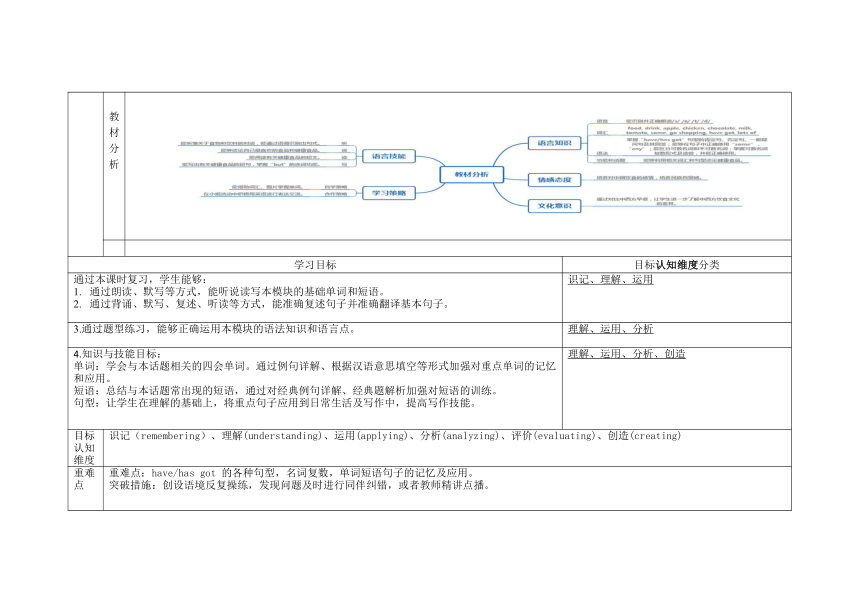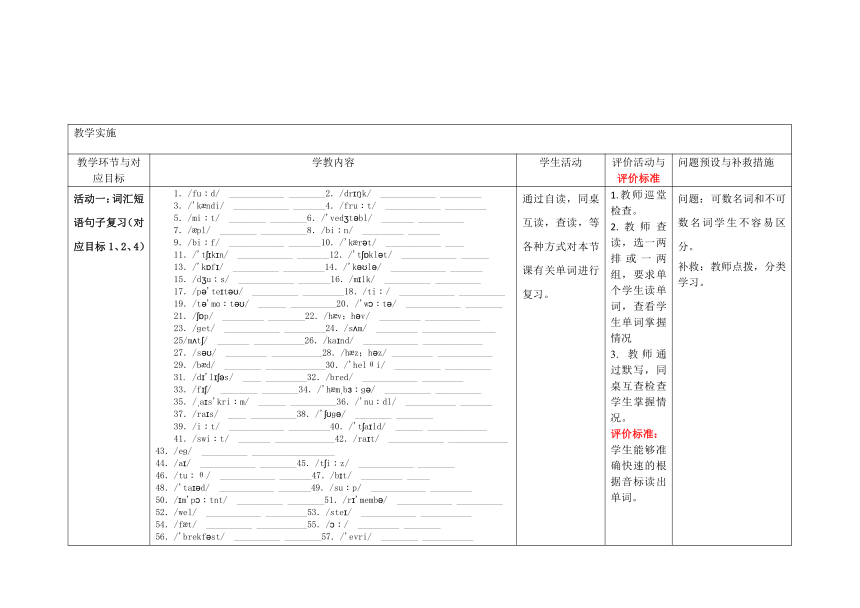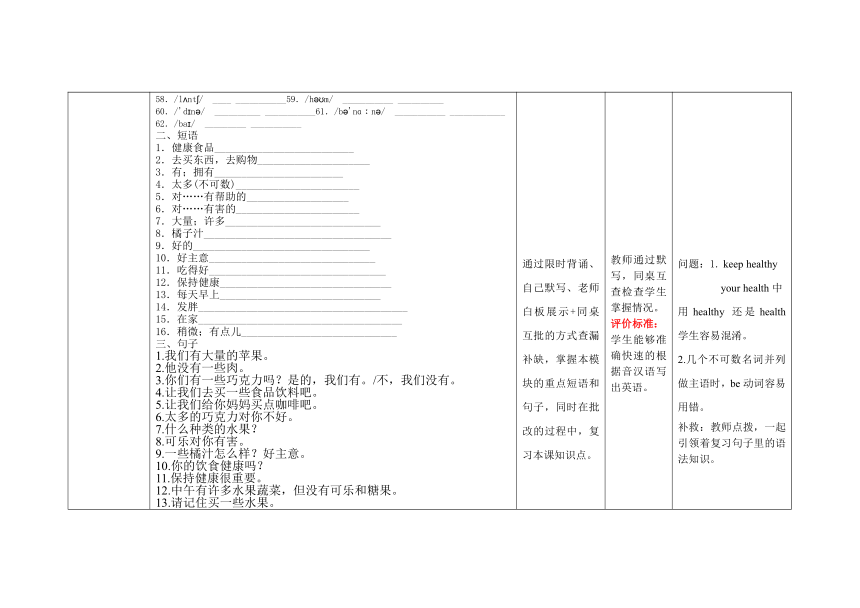英语七年级第十周Module 4 Healthy food复习课教案
文档属性
| 名称 | 英语七年级第十周Module 4 Healthy food复习课教案 |  | |
| 格式 | docx | ||
| 文件大小 | 113.2KB | ||
| 资源类型 | 教案 | ||
| 版本资源 | 外研版 | ||
| 科目 | 英语 | ||
| 更新时间 | 2022-07-26 21:49:09 | ||
图片预览




文档简介
课时备课
课题 七上Module4复习课
日期 课时 1 课型 复习课 授课教师
目标 确立 依据 课标 分析 课标摘录 义务教育《英语课程标准》语言技能三级标准: 有明确的学习需要和目标,对英语学习表现出较强的自信心。(情感态度) 能听懂有关熟悉话题的语段,能识别不同句式的语调,如陈述句、疑问句和指令等。(语言知识、语言技能) 能读懂简单的故事和短文并抓住大意。能与教师或同学就熟悉的话题交换信息。(语言知识、语言技能) 能尝试使用适当的学习方法,克服学习中遇到的困难。(学习策略) 能意识到语言交际中存在文化差异。(文化意识)
课标分解 能听懂(不)可数名词及进行分辨。 (2)能就熟悉的话题进行简单的交流。 (3)能根据提示简单介绍自己的饮食生活。 (4)根据所学内容就饮食生活这个话题交换信息。
教材 分析
学习目标 目标认知维度分类
通过本课时复习,学生能够: 通过朗读、默写等方式,能听说读写本模块的基础单词和短语。 通过背诵、默写、复述、听读等方式,能准确复述句子并准确翻译基本句子。 识记、理解、运用
3.通过题型练习,能够正确运用本模块的语法知识和语言点。 理解、运用、分析
4.知识与技能目标: 单词:学会与本话题相关的四会单词。通过例句详解、根据汉语意思填空等形式加强对重点单词的记忆和应用。 短语:总结与本话题常出现的短语,通过对经典例句详解、经典题解析加强对短语的训练。 句型:让学生在理解的基础上,将重点句子应用到日常生活及写作中,提高写作技能。 理解、运用、分析、创造
目标认知维度 识记(remembering)、理解(understanding)、运用(applying)、分析(analyzing)、评价(evaluating)、创造(creating)
重难点 重难点:have/has got 的各种句型,名词复数,单词短语句子的记忆及应用。 突破措施:创设语境反复操练,发现问题及时进行同伴纠错,或者教师精讲点播。
教学实施
教学环节与对应目标 学教内容 学生活动 评价活动与评价标准 问题预设与补救措施
活动一:词汇短语句子复习(对应目标1、2、4) 1./fu d/ ____________ ________2./dr k/ ____________ _________ 3./'k ndi/ ____________ _______4./fru t/ ____________ _________ 5./mi t/ ________ ________6./'ved t bl/ _______ __________ 7./ pl/ ________ __________8./bi n/ _________ _______ 9./bi f/ ____________ _______10./'k r t/ ____________ ____ 11./'t k n/ ____________ _______12./'t kl t/ ____________ ______ 13./'k f / __________ _________14./'k l / ____________ _______ 15./d u s/ ____________ _______16./m lk/ __________ __________ 17./p 'te t / __________ _________18./ti / ____________ __________ 19./t 'mɑ t / ______ __________20./'w t / ____________ ________ 21./ p/ _________ ________22./h v;h v/ _________ ____________ 23./ɡet/ ____________ _________24./s m/ _________ ________________ 25/m t / _______ ___________26./ka nd/ ____________ _____________ 27./s / _________ ___________28./h z;h z/ _________ ____________ 29./b d/ ________ _____________30./'helθi/ __________ __________ 31. /d 'l s/ ____ _________32./bred/ ____________ _________ 33./f / ________ ________34./'h m b ɡ / __________ __________ 35./ a s'kri m/ ______ __________36./'nu dl/ ___________ _______ 37./ra s/ ____ __________38./' ɡ / ________ ________ 39./i t/ ____________ _________40./'t a ld/ ______ _____________ 41./swi t/ _______ _____________42./ra t/ ____________ _____________ 43./eɡ/ __________ __________________ 44./a / ____________ ________45./t i z/ ____________ ________ 46./tu θ/ ____________ _______47./b t/ _________ _____ 48./'ta d/ ____________ _______49./su p/ ____________ _________ 50./ m'p tnt/ __________ ________51./r 'memb / ____________ __________ 52./wel/ ____________ _________53./ste / ____________ ___________ 54./f t/ __________ ___________55./ / _________ ________ 56./'brekf st/ __________ ________57./'evri/ ________ ___________ 58./l nt / ____ ___________59./h m/ ___________ __________ 60./'d n / __________ ___________61./b 'nɑ n / ___________ ____________ 62./ba / _________ ___________ 二、短语 1.健康食品__________________________ 2.去买东西,去购物_____________________ 3.有;拥有________________________ 4.太多(不可数)_______________________ 5.对……有帮助的___________________ 6.对……有害的_______________________ 7.大量;许多_____________________________ 8.橘子汁___________________________________ 9.好的_________________________________ 10.好主意_______________________________ 11.吃得好_________________________________ 12.保持健康________________________________ 13.每天早上______________________________ 14.发胖_______________________________________ 15.在家______________________________________ 16.稍微;有点儿_____________________________ 三、句子 1.我们有大量的苹果。 2.他没有一些肉。 3.你们有一些巧克力吗?是的,我们有。/不,我们没有。 4.让我们去买一些食品饮料吧。 5.让我们给你妈妈买点咖啡吧。 6.太多的巧克力对你不好。 7.什么种类的水果? 8.可乐对你有害。 9.一些橘汁怎么样?好主意。 10.你的饮食健康吗? 11.保持健康很重要。 12.中午有许多水果蔬菜,但没有可乐和糖果。 13.请记住买一些水果。 14.我有一点累。 1.We’ve got lots of apples. 2.He hasn’t got any meat. 3.Have you got any chocolate Yes, we have. / No, we haven’t. 4.Let’s go shopping for food and drink. 5.Let’s get some coffee for your mum. 6.Too much chocolate isn’t good for you. 7.What kind of fruit 8.Cola is bad for you. 9.How about some orange juice?Good idea. 10.Is your food and drink healthy 11.It is important to stay healthy. 12.There are lots of fruit and vegetables for lunch, but there isn’t any cola or candy . 13.Please remember to buy some fruit. 14.I’m a bit tired. 通过自读,同桌互读,查读,等各种方式对本节课有关单词进行复习。 通过限时背诵、自己默写、老师白板展示+同桌互批的方式查漏补缺,掌握本模块的重点短语和句子,同时在批改的过程中,复习本课知识点。 1.教师巡堂检查。 2.教师查读,选一两排或一两组,要求单个学生读单词,查看学生单词掌握情况 3. 教师通过默写,同桌互查检查学生掌握情况。 评价标准: 学生能够准确快速的根据音标读出单词。 教师通过默写,同桌互查检查学生掌握情况。 评价标准: 学生能够准确快速的根据音汉语写出英语。 问题: 可数名词和不可数名词学生不容易区分。 补救:教师点拨,分类学习。 问题:1. keep healthy your health中 用healthy 还是health学生容易混淆。 2.几个不可数名词并列做主语时,be动词容易用错。 补救:教师点拨,一起引领着复习句子里的语法知识。
活动三:语法知识与知识运用练习。 (对应目标4) 基本语法点: ①have/has got 的含义及句子结构。 注意there be的区别,以及和have/has的替换。 ②可数名词和不可数名词 ③some 和any的用法 活动三: 1 学生根据语法点复习。 2 完成相应的练习题。 1 组内检查 2 小组讨论 3 教师点拨 问题:个别同学对some,any的用法会不清晰准确。 补救:组内同学再次练习,互相指正,教师点拨。
活动三:题型练习(对应目标3、4) 3.译句练习 一、词汇应用 1.She likes eating (chicken) very much. 2.There are some (tomato) on the table. 3.She has (get) so much chocolate. 4.Let’s go to the shop to buy some (vegetable). 5.We haven’t got (some) meat at home. 6.Noodles and rice are (health) food. 7.Milk and cheese (be) good for your (tooth) 8.It is important (have) a good breakfast. 9.Most (child) like candy. 10.(not go) swimming this afternoon. 11.Lingling (have) got a red bike. 12. (be) there any beef in the fridge. 13.Can you go (shop) with me 14.Do you like (noodle). 15.I have got 28 (tooth). 16.Daming’s food is not (health). 17.It is interesting (fly) kites. 18.Let’s (give) them some bread. 19.People usually have three meals a day: _____, lunch, and dinner. It's important to eat _____ (good).For breakfast, people usually eat bread and eggs and drink coffee _____ tea, milk and fruit juice. How _____cola No, it's bad _____ you. It's good to eat _____ (any) meat for lunch, but eating too _____ (many) meat is not healthy. It's important to have lots of fruit and _____ (vegetable) for lunch, too. Carrots and sweet potatoes are good for your eyes. You can have them for dinner. Remember not to eat _____ (some) candies before your sleep. They are sweet and bad for your _____ (tooth). 二、句型转换 1. We have got some fruit.(改为否定句) We _________ _________ _________ fruit. 2. She has got some beef.(改为一般疑问句) _________ _________ _________ any beef 3. -Has the boy got any sisters (作肯定回答) -Yes, _________ _________. 4. -Have they got any information?(作否定回答) -No, _________ _________. 5. Tony has got some juice.(改为否定句) Tony _________ got _________ juice. 6. Beef is healthy food. Rice is healthy food, too. (合并为一句) Beef _________ rice _________ healthy food. 7. We have carrots and potatoes for dinner. (对画线部分提问) _________ do you have _________ _________ 8. Chocolate isn't healthy. It's my favourite. (用but连接两个句子) Chocolate isn't healthy _________ it's my favourite. 9. meat, not, your, much, is, for, too, health, good(连词成句) ______________________________________________________. 10. To have a healthy breakfast is good. (改为同义句) _________ good _________ _________ a healthy breakfast. 11. are good for, fruits and vegetables, to keep fit, people, fresh (连词成句) _____________________________________________. 翻译句子 1. 托尼,让我们去买食物和饮料吧。 Tony, let's _________ _________ for food and drinks. 2. 冰箱里有许多食物。 There is ________ _________ food in the fridge. 3 她有鸡肉吗? _________ _________ _________ any chicken 4. 我们没有水果。 _________ _________ _________ any fruit. 5. 让我们去打篮球吧。 _________ _________ basketball. 6. 我们有什么种类的水果? _________ _________ of fruit have we got 7. 不要吃太多巧克力。 Don't eat _________ _________ chocolate. 8.牛奶、奶酪和鱼对你的牙齿有益。 Milk, cheese and fish are _________ _________ your teeth. 9. 面条和米饭是健康的食物。 _________ and _________ _________ healthy food. 10. 我最喜欢的食物是牛肉。 My ________ __________ _________beef. 11. 果汁和牛奶是健康饮品吗? _________ juice and milk _________ _________? 12.. 那个小女孩最喜欢喝的是可乐。 The little girl's _________ _________ is _________. 13.甜食对你的牙齿是有害的。 Sweet food is _________ _________ your teeth. 14.多吃水果和蔬菜,你就不会变胖。 Eat more fruit and vegetables and you won't _________ _________. 15.在下雪天和我的朋友们一起堆雪人很有趣。 _________ _________ _________ _________ make snowmen with my friends on snowy days. 学生限时做题,即时订正答案,错题先组内讨论,疑难问题由老师点拨。 同桌互相订正答案,老师统计出错率 评价标准:题目做对 预设问题:在翻译句子中,学生的三单容易忘记,has容易写成has; It做形式主语的句型,学生可能掌握不好,动词形式可能出错; 学生在翻译句子时,可能一般疑问句和特殊疑问句混淆,不知道该怎么翻译。 补救措施:对易错点进行方法的指导与讲解,强化练习。
作业设计 1.整理错题笔记2.做本模块对应的阅读理解3.进行模块话题写作。
教后反思 Teacher should give students more time to correct the mistakes.
课题 七上Module4复习课
日期 课时 1 课型 复习课 授课教师
目标 确立 依据 课标 分析 课标摘录 义务教育《英语课程标准》语言技能三级标准: 有明确的学习需要和目标,对英语学习表现出较强的自信心。(情感态度) 能听懂有关熟悉话题的语段,能识别不同句式的语调,如陈述句、疑问句和指令等。(语言知识、语言技能) 能读懂简单的故事和短文并抓住大意。能与教师或同学就熟悉的话题交换信息。(语言知识、语言技能) 能尝试使用适当的学习方法,克服学习中遇到的困难。(学习策略) 能意识到语言交际中存在文化差异。(文化意识)
课标分解 能听懂(不)可数名词及进行分辨。 (2)能就熟悉的话题进行简单的交流。 (3)能根据提示简单介绍自己的饮食生活。 (4)根据所学内容就饮食生活这个话题交换信息。
教材 分析
学习目标 目标认知维度分类
通过本课时复习,学生能够: 通过朗读、默写等方式,能听说读写本模块的基础单词和短语。 通过背诵、默写、复述、听读等方式,能准确复述句子并准确翻译基本句子。 识记、理解、运用
3.通过题型练习,能够正确运用本模块的语法知识和语言点。 理解、运用、分析
4.知识与技能目标: 单词:学会与本话题相关的四会单词。通过例句详解、根据汉语意思填空等形式加强对重点单词的记忆和应用。 短语:总结与本话题常出现的短语,通过对经典例句详解、经典题解析加强对短语的训练。 句型:让学生在理解的基础上,将重点句子应用到日常生活及写作中,提高写作技能。 理解、运用、分析、创造
目标认知维度 识记(remembering)、理解(understanding)、运用(applying)、分析(analyzing)、评价(evaluating)、创造(creating)
重难点 重难点:have/has got 的各种句型,名词复数,单词短语句子的记忆及应用。 突破措施:创设语境反复操练,发现问题及时进行同伴纠错,或者教师精讲点播。
教学实施
教学环节与对应目标 学教内容 学生活动 评价活动与评价标准 问题预设与补救措施
活动一:词汇短语句子复习(对应目标1、2、4) 1./fu d/ ____________ ________2./dr k/ ____________ _________ 3./'k ndi/ ____________ _______4./fru t/ ____________ _________ 5./mi t/ ________ ________6./'ved t bl/ _______ __________ 7./ pl/ ________ __________8./bi n/ _________ _______ 9./bi f/ ____________ _______10./'k r t/ ____________ ____ 11./'t k n/ ____________ _______12./'t kl t/ ____________ ______ 13./'k f / __________ _________14./'k l / ____________ _______ 15./d u s/ ____________ _______16./m lk/ __________ __________ 17./p 'te t / __________ _________18./ti / ____________ __________ 19./t 'mɑ t / ______ __________20./'w t / ____________ ________ 21./ p/ _________ ________22./h v;h v/ _________ ____________ 23./ɡet/ ____________ _________24./s m/ _________ ________________ 25/m t / _______ ___________26./ka nd/ ____________ _____________ 27./s / _________ ___________28./h z;h z/ _________ ____________ 29./b d/ ________ _____________30./'helθi/ __________ __________ 31. /d 'l s/ ____ _________32./bred/ ____________ _________ 33./f / ________ ________34./'h m b ɡ / __________ __________ 35./ a s'kri m/ ______ __________36./'nu dl/ ___________ _______ 37./ra s/ ____ __________38./' ɡ / ________ ________ 39./i t/ ____________ _________40./'t a ld/ ______ _____________ 41./swi t/ _______ _____________42./ra t/ ____________ _____________ 43./eɡ/ __________ __________________ 44./a / ____________ ________45./t i z/ ____________ ________ 46./tu θ/ ____________ _______47./b t/ _________ _____ 48./'ta d/ ____________ _______49./su p/ ____________ _________ 50./ m'p tnt/ __________ ________51./r 'memb / ____________ __________ 52./wel/ ____________ _________53./ste / ____________ ___________ 54./f t/ __________ ___________55./ / _________ ________ 56./'brekf st/ __________ ________57./'evri/ ________ ___________ 58./l nt / ____ ___________59./h m/ ___________ __________ 60./'d n / __________ ___________61./b 'nɑ n / ___________ ____________ 62./ba / _________ ___________ 二、短语 1.健康食品__________________________ 2.去买东西,去购物_____________________ 3.有;拥有________________________ 4.太多(不可数)_______________________ 5.对……有帮助的___________________ 6.对……有害的_______________________ 7.大量;许多_____________________________ 8.橘子汁___________________________________ 9.好的_________________________________ 10.好主意_______________________________ 11.吃得好_________________________________ 12.保持健康________________________________ 13.每天早上______________________________ 14.发胖_______________________________________ 15.在家______________________________________ 16.稍微;有点儿_____________________________ 三、句子 1.我们有大量的苹果。 2.他没有一些肉。 3.你们有一些巧克力吗?是的,我们有。/不,我们没有。 4.让我们去买一些食品饮料吧。 5.让我们给你妈妈买点咖啡吧。 6.太多的巧克力对你不好。 7.什么种类的水果? 8.可乐对你有害。 9.一些橘汁怎么样?好主意。 10.你的饮食健康吗? 11.保持健康很重要。 12.中午有许多水果蔬菜,但没有可乐和糖果。 13.请记住买一些水果。 14.我有一点累。 1.We’ve got lots of apples. 2.He hasn’t got any meat. 3.Have you got any chocolate Yes, we have. / No, we haven’t. 4.Let’s go shopping for food and drink. 5.Let’s get some coffee for your mum. 6.Too much chocolate isn’t good for you. 7.What kind of fruit 8.Cola is bad for you. 9.How about some orange juice?Good idea. 10.Is your food and drink healthy 11.It is important to stay healthy. 12.There are lots of fruit and vegetables for lunch, but there isn’t any cola or candy . 13.Please remember to buy some fruit. 14.I’m a bit tired. 通过自读,同桌互读,查读,等各种方式对本节课有关单词进行复习。 通过限时背诵、自己默写、老师白板展示+同桌互批的方式查漏补缺,掌握本模块的重点短语和句子,同时在批改的过程中,复习本课知识点。 1.教师巡堂检查。 2.教师查读,选一两排或一两组,要求单个学生读单词,查看学生单词掌握情况 3. 教师通过默写,同桌互查检查学生掌握情况。 评价标准: 学生能够准确快速的根据音标读出单词。 教师通过默写,同桌互查检查学生掌握情况。 评价标准: 学生能够准确快速的根据音汉语写出英语。 问题: 可数名词和不可数名词学生不容易区分。 补救:教师点拨,分类学习。 问题:1. keep healthy your health中 用healthy 还是health学生容易混淆。 2.几个不可数名词并列做主语时,be动词容易用错。 补救:教师点拨,一起引领着复习句子里的语法知识。
活动三:语法知识与知识运用练习。 (对应目标4) 基本语法点: ①have/has got 的含义及句子结构。 注意there be的区别,以及和have/has的替换。 ②可数名词和不可数名词 ③some 和any的用法 活动三: 1 学生根据语法点复习。 2 完成相应的练习题。 1 组内检查 2 小组讨论 3 教师点拨 问题:个别同学对some,any的用法会不清晰准确。 补救:组内同学再次练习,互相指正,教师点拨。
活动三:题型练习(对应目标3、4) 3.译句练习 一、词汇应用 1.She likes eating (chicken) very much. 2.There are some (tomato) on the table. 3.She has (get) so much chocolate. 4.Let’s go to the shop to buy some (vegetable). 5.We haven’t got (some) meat at home. 6.Noodles and rice are (health) food. 7.Milk and cheese (be) good for your (tooth) 8.It is important (have) a good breakfast. 9.Most (child) like candy. 10.(not go) swimming this afternoon. 11.Lingling (have) got a red bike. 12. (be) there any beef in the fridge. 13.Can you go (shop) with me 14.Do you like (noodle). 15.I have got 28 (tooth). 16.Daming’s food is not (health). 17.It is interesting (fly) kites. 18.Let’s (give) them some bread. 19.People usually have three meals a day: _____, lunch, and dinner. It's important to eat _____ (good).For breakfast, people usually eat bread and eggs and drink coffee _____ tea, milk and fruit juice. How _____cola No, it's bad _____ you. It's good to eat _____ (any) meat for lunch, but eating too _____ (many) meat is not healthy. It's important to have lots of fruit and _____ (vegetable) for lunch, too. Carrots and sweet potatoes are good for your eyes. You can have them for dinner. Remember not to eat _____ (some) candies before your sleep. They are sweet and bad for your _____ (tooth). 二、句型转换 1. We have got some fruit.(改为否定句) We _________ _________ _________ fruit. 2. She has got some beef.(改为一般疑问句) _________ _________ _________ any beef 3. -Has the boy got any sisters (作肯定回答) -Yes, _________ _________. 4. -Have they got any information?(作否定回答) -No, _________ _________. 5. Tony has got some juice.(改为否定句) Tony _________ got _________ juice. 6. Beef is healthy food. Rice is healthy food, too. (合并为一句) Beef _________ rice _________ healthy food. 7. We have carrots and potatoes for dinner. (对画线部分提问) _________ do you have _________ _________ 8. Chocolate isn't healthy. It's my favourite. (用but连接两个句子) Chocolate isn't healthy _________ it's my favourite. 9. meat, not, your, much, is, for, too, health, good(连词成句) ______________________________________________________. 10. To have a healthy breakfast is good. (改为同义句) _________ good _________ _________ a healthy breakfast. 11. are good for, fruits and vegetables, to keep fit, people, fresh (连词成句) _____________________________________________. 翻译句子 1. 托尼,让我们去买食物和饮料吧。 Tony, let's _________ _________ for food and drinks. 2. 冰箱里有许多食物。 There is ________ _________ food in the fridge. 3 她有鸡肉吗? _________ _________ _________ any chicken 4. 我们没有水果。 _________ _________ _________ any fruit. 5. 让我们去打篮球吧。 _________ _________ basketball. 6. 我们有什么种类的水果? _________ _________ of fruit have we got 7. 不要吃太多巧克力。 Don't eat _________ _________ chocolate. 8.牛奶、奶酪和鱼对你的牙齿有益。 Milk, cheese and fish are _________ _________ your teeth. 9. 面条和米饭是健康的食物。 _________ and _________ _________ healthy food. 10. 我最喜欢的食物是牛肉。 My ________ __________ _________beef. 11. 果汁和牛奶是健康饮品吗? _________ juice and milk _________ _________? 12.. 那个小女孩最喜欢喝的是可乐。 The little girl's _________ _________ is _________. 13.甜食对你的牙齿是有害的。 Sweet food is _________ _________ your teeth. 14.多吃水果和蔬菜,你就不会变胖。 Eat more fruit and vegetables and you won't _________ _________. 15.在下雪天和我的朋友们一起堆雪人很有趣。 _________ _________ _________ _________ make snowmen with my friends on snowy days. 学生限时做题,即时订正答案,错题先组内讨论,疑难问题由老师点拨。 同桌互相订正答案,老师统计出错率 评价标准:题目做对 预设问题:在翻译句子中,学生的三单容易忘记,has容易写成has; It做形式主语的句型,学生可能掌握不好,动词形式可能出错; 学生在翻译句子时,可能一般疑问句和特殊疑问句混淆,不知道该怎么翻译。 补救措施:对易错点进行方法的指导与讲解,强化练习。
作业设计 1.整理错题笔记2.做本模块对应的阅读理解3.进行模块话题写作。
教后反思 Teacher should give students more time to correct the mistakes.
同课章节目录
- Starte
- Module 1 My teacher and my friends
- Module 2 My English lesson
- Module 3 My English book
- Module 4 My everyday life
- Module 1 My classmates
- Unit 1 Nice to meet you.
- Unit 2 I'm Wang Lingling and I'm thirteen years ol
- Unit 3 Language in use.
- Module 2 My family
- Unit 1 Is this your mum?
- Unit 2 These are my parents.
- Unit 3 Language in use.
- Module 3 My school
- Unit 1 There are thirty students in my class.
- Unit 2 The library is on the left of the playgroun
- Unit 3 Language in use.
- Module 4 Healthy food
- Unit 1 We've got lots of apples.
- Unit 2 Is your food and drink healthy?
- Unit 3 Language in use.
- Module 5 My school day
- Unit 1 I love history.
- Unit 2 We start work at nine o'clock.
- Unit 3 Language in use.
- Revision module A
- Module 6 A trip to the zoo
- Unit 1 Does it eat meat?
- Unit 2 The tiger lives in Asia.
- Unit 3 Language in use.
- Module 7 Computers
- Unit 1 How do I write my homework on the computer?
- Unit 2 When do you use a computer?
- Unit 3 Language in use.
- Module 8 Choosing presents
- Unit 1 I always like birthday parties.
- Unit 2 She often goes to concerts.
- Unit 3 Language in use.
- Module 9 People and places
- Unit 1 We're enjoying the school trip a lot.
- Unit 2 They're waiting for buses or trains.
- Unit 3 Language in use.
- Module 10 Spring Festival
- Unit 1 Are you getting ready for Spring Festival?
- Unit 2 My mother's cleaning our houses and sweepin
- Unit 3 Language in use.
- Revision module B
